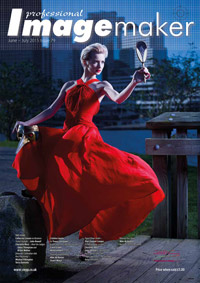articles/Lighting/light-part37-page3
Creating With Light - Part 37 - Hypersync - part 3 of 1 2 3 4
by Dave Montizambert Published 01/06/2015
To make the strobe burst on Kelsey read f16 for a f4 real exposure, I cannot change power on the strobe - it must be set to full power for the longest flash duration possible - I can only alter exposure on the subject by changing the distance of the light or by feathering the light. Since these distances will always be the same, I shot a test which is basically a Guide Value test. For this Hypersync test set-up shoot, I used trial and error to figure out what distance the strobe needs to be from the subject to create a perfect exposure at full power. Now measuring distances at the time of the shoot is cumbersome, so at the time of the test, once the right distance for the strobe was found, I took a meter reading to see what the meter would read, even though this reading is not what my subject will get I can use it as a correlation. After I found the perfect distance for the strobe to get a perfect strobe exposure on my subject with camera set to f4 at 1⁄1,600th-of-asecond at 100 ISO, I found that my light read almost f16. I then documented this correlation, and then did the same for other high-speed shutter-speeds that I might need to HyperSync to. So in my test I observed a one stop gain in strobe lighting with every one-stop decrease in shutter-speed. Basically if I want to shoot at f4 at 1⁄1,600th, then I need to alter the strobe's distance from the subject until it reads f16-using my Sekonic flash-meter in incident mode.
Once I've programmed the offset into the Flex TT5, which you have to do by connecting the Flex TT5 to my laptop via USB, I set the camera shutter to 1⁄160th of a second and took a shot with the FlexTT5 hooked up to the camera-this first shot is a calibration shot, once done you can delete this frame. The strobe will not fire when you do this test shot, but that's okay and once done I set camera back to the shutter I really want to shoot at and from here on the Pocket Wizard will trigger the strobe.
So by setting the strobe to its highest power to ensure the longest strobe burst duration possible, and then by tricking the whole system with an offset set on the Pocket Wizard Flex TT5, I'm able to use strobe lightingwith high shutter-speeds. This technique works best on strobes that take longer to dump their full charge of light onto the subject. The most suitable strobes are typically older and/or more powerful models - older is better because newer designs tend to use more capacitors and so dump faster, perfect for freezing action but not a good thing for Hypersync. Also, those units that generate more light, need more time to dump this charge onto the subject. So in a nutshell, slower (within reason) is better!
So there you have it, yet another mixed lighting set-up fully exploiting the available light sources - sun and open sky with a mix of heavily modified strobe lighting. At the request of Pocket Wizard, I created an in-depth how to video during this shoot as well as a video on how to perform the required preliminary Hypersync set-up test. These should be ready to view on my website and/or the Pocket Wizard website in June or July. Next article we'll look at doing the Hypersync set-up test.
Please Note:
There is more than one page for this Article.
You are currently on page 3
- Creating With Light - Part 37 - Hypersync page 1
- Creating With Light - Part 37 - Hypersync page 2
- Creating With Light - Part 37 - Hypersync page 3
- Creating With Light - Part 37 - Hypersync page 4
1st Published 01/06/2015
last update 09/12/2022 14:55:57
More Lighting Articles
There are 27 days to get ready for The Society of Photographers Convention and Trade Show at The Novotel London West, Hammersmith ...
which starts on Wednesday 14th January 2026





